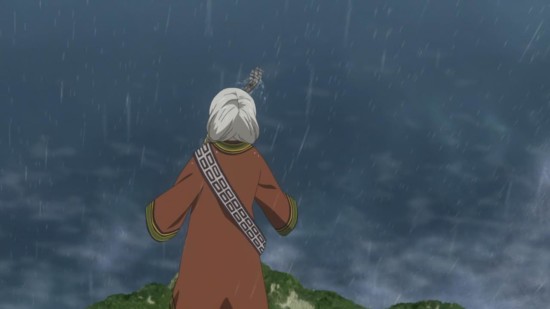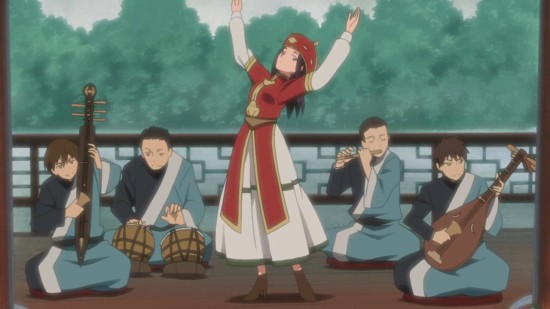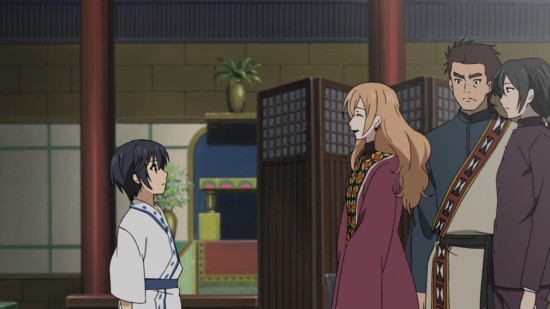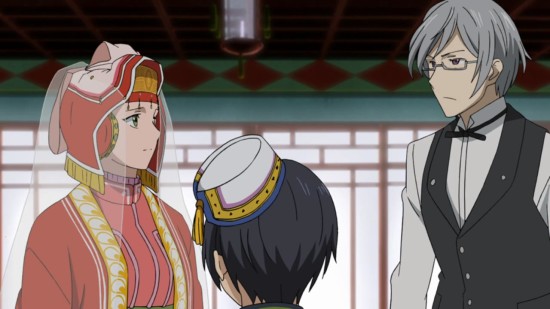At the time I wrote my “early impressions” post I thought The World is Still Beautiful” (Crunchyroll) was my favorite anime of the Spring season. It later fell in my estimation, but I have to admit that the ending was great!

While a traditional fairy tale would commonly end at the point where the heroine was chosen to marry the king, this one starts at that point. It is wise enough to recognize that this is when her real problems would begin.
But the show lost some energy in the middle section. Livi seemed most interesting when he was a spoiled tyrant. Things seemed to sag a bit once he started spouting the romantic lines expected of a shoujo leading man. That had to happen eventually but I couldn’t help feeling that Nike won him over too quickly. Part of the problem may stem from the difficulties of cramming 7 manga volumes into 12 anime episodes.
Some of the problems that Nike faced seemed pretty realistic. Others seemed less plausible. The heart of the matter is the question of how skillful the writers are at constructing a believable fictional world.

The Sun Kingdom is, of course, inspired by the France of Louis XIV (the original “Sun King”) but with a lot of anachronisms. Most of the costumes seem to be from the 18th century and that castle looks like the handiwork of that famous 19th century monarch Mad King Ludwig.
The politics of the kingdom make a certain amount of historical sense. The king is hated by many of the noblemen (a strong king threatens their prerogatives) but is popular with the common people (who look to the king to protect them from rapacious aristocrats.) The genius boy king was originally placed on the throne by his playboy uncle, who didn’t want to be tied down by taking the throne himself, but was willing to provide guidance until Livi was ready to take power in his own hands.

On the other hand, in some ways Nike seems to have too easy a time of it. Historically foreign-born queens have been greeted with suspicion and have served as a lightning rod for any discontent with the regime. The more powerful the king, the safer it is to direct criticism at his foreign bride. We do see some of this, but not enough. In reality Nike would probably have to work very hard for many years to become really popular.
(And her weather magic probably wouldn’t help in the least. Accusing the queen of witchcraft is one of the hoariest slanders.)

The genius of the ending is that it moves the action back to the Rain Principality, an intriguing place where the architecture and traditional costumes reflect a mix of East Asian styles. (We’re told that the people of the two countries are racially distinct–so even though everyone is drawn in standard manga/anime style it’s easy to make a guess at what the characters “really” look like.)

Being in a foreign land and surrounded by powerful people who are not his subjects gives Livi a chance the grow and shine as a character. This helps give the ending a depth and power that I had not expected.

A quibble about the translation: European and Japanese titles of nobility don’t match exactly. In English the ruler of a “principality” should be a prince, not a duke, and the daughter of a duke would not be a princess. (In Japanese any young noblewoman can be called “hime”.) Confusingly, in some countries a “grand duke” is equivalent to a prince, but country ruled by a grand duke should be a “grand duchy.”

